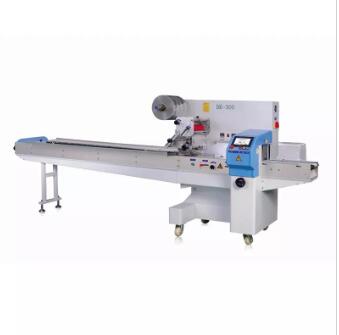Precision Stacking: Demystifying the Functionality of Palletizing Machinery
2023-11-10
Introduction:
In the dynamic world of logistics and manufacturing, the efficient handling and stacking of products play a pivotal role in streamlining operations. Palletizing machinery, with its automated precision, has become a cornerstone in this process. This blog aims to unravel the function of palletizing machinery, exploring how it operates to optimize the stacking and organization of products on pallets for seamless transport and storage.
Section 1: Understanding Palletizing Machinery
Palletizing machinery is an automated system designed to arrange and stack products onto pallets with precision and efficiency. This technology has revolutionized the manual and time-consuming task of palletizing, offering a faster, more accurate, and cost-effective solution for industries dealing with large volumes of products.
Section 2: Key Components of Palletizing Machinery
1. Conveyor System:
- A conveyor system transports products to the palletizing area. This can include roller conveyors, belt conveyors, or other mechanisms to facilitate the movement of products.
2. Robotic Arm or Layer Forming Mechanism:
- The heart of palletizing machinery, the robotic arm or layer forming mechanism, is responsible for picking up products and precisely placing them on the pallet. The design may include multiple arms or end-of-arm tools for diverse handling capabilities.
3. Pallet Dispenser:
- Some palletizing systems feature a pallet dispenser that automatically supplies pallets to the palletizing area. This ensures a continuous workflow without the need for manual pallet placement.
4. Control System:
- The control system oversees the entire palletizing process, coordinating the movements of the robotic arm, conveyor system, and any additional components. It also allows for customization of stacking patterns and configurations.
5. Safety Features:
- Modern palletizing machinery is equipped with safety features such as sensors and barriers to ensure a secure working environment and prevent accidents.
Section 3: How Palletizing Machinery Operates
1. Product Infeed:
- Products are fed into the palletizing machinery through the conveyor system. The system may handle individual items, cases, or entire layers of products, depending on the design.
2. Layer Formation:
- The robotic arm or layer forming mechanism picks up products and arranges them into predefined layers. This can involve various patterns and configurations based on the stacking requirements.
3. Pallet Placement:
- Simultaneously, the palletizing machinery positions a pallet in the correct location for the stacking process. If equipped with a pallet dispenser, it automatically supplies new pallets as needed.
4. Precise Stacking:
- The robotic arm meticulously places each layer of products onto the pallet, adhering to the specified stacking pattern. This process repeats until the desired number of layers is achieved.
5. Interlayer Sheets or Pads (Optional):
- In some applications, interlayer sheets or pads may be inserted between product layers to provide stability, prevent damage, or meet specific stacking requirements.
6. Top Sheet or Hood (Optional):
- For added protection, palletizing machinery may incorporate the placement of top sheets or hoods over the completed palletized stack.
7. Quality Control:
- Vision systems or sensors may be integrated into the machinery to inspect the stacked pallet for any misalignments, missing products, or irregularities. This ensures the quality and integrity of the palletized load.
8. Pallet Conveyance:
- Once the palletizing process is complete, the palletized load is conveyed to the next stage of the logistics or manufacturing process. This can include wrapping, labeling, or direct shipment.
Section 4: Applications Across Industries
Palletizing machinery finds applications across diverse industries, optimizing the handling of products in various forms:
1. Distribution Centers and Warehousing:
- Palletizing machinery is extensively used in distribution centers and warehouses to efficiently stack and organize products for storage and retrieval.
2. Manufacturing:
- In manufacturing plants, palletizing machinery streamlines the packaging process by automating the stacking of finished goods or components.
3. Food and Beverage:
- Palletizing machinery is employed in the food and beverage industry to handle cases of packaged goods, ensuring efficient stacking for storage and transportation.
4. Consumer Goods:
- Industries producing consumer goods, including electronics, appliances, and household items, utilize palletizing machinery to organize and stack products for shipping.
5. Automotive:
- Palletizing machinery is used in the automotive industry to stack and palletize components and finished products, optimizing logistics and storage.
6. Pharmaceuticals:
- Pharmaceutical manufacturing facilities utilize palletizing machinery to handle palletized loads of medications, ensuring precision and compliance with industry standards.
Section 5: Benefits of Palletizing Machinery for Manufacturers
The adoption of palletizing machinery offers manufacturers several advantages:
1. Increased Efficiency:
- Palletizing machinery significantly increases the speed and efficiency of the palletizing process, reducing the time required for manual handling.
2. Precision and Consistency:
- Automated palletizing ensures precise and consistent stacking, minimizing the risk of errors associated with manual labor.
3. Labor Savings:
- Palletizing machinery reduces the need for manual labor in the palletizing process, leading to cost savings and allowing workers to focus on higher-value tasks.
4. Customization:
- The control system of palletizing machinery allows for easy customization of stacking patterns, accommodating different product sizes and configurations.
5. Space Optimization:
- Automated palletizing optimizes space utilization in warehouses by creating well-organized and stable palletized loads.
6. Safety:
- Palletizing machinery enhances workplace safety by minimizing manual lifting and reducing the risk of injuries associated with heavy lifting and repetitive tasks.
Conclusion:
Palletizing machinery stands as a testament to the evolution of automated solutions in the manufacturing and logistics landscape. By automating the intricate task of palletizing, these machines not only enhance efficiency and precision but also contribute to a safer and more streamlined operational environment. As technology continues to advance, the role of palletizing machinery is poised to expand, offering innovative solutions for industries seeking to optimize their product handling and distribution processes.



